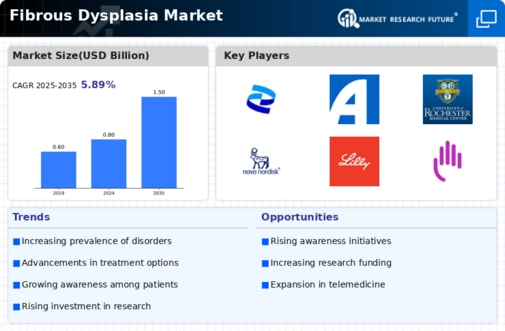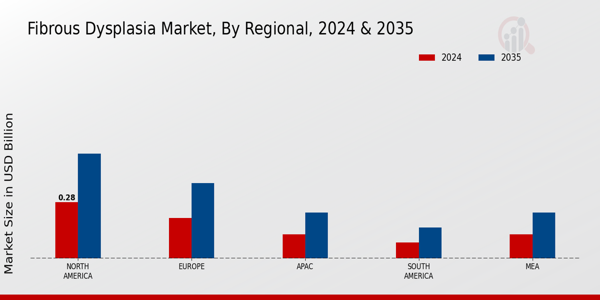Market Growth Projections
Charts depicting the projected growth of the Global Fibrous Dysplasia Market Industry illustrate a promising trajectory. The market is anticipated to reach a valuation of 0.8 USD Billion in 2024, with expectations to grow to 1.5 USD Billion by 2035. The compound annual growth rate (CAGR) of 5.88% from 2025 to 2035 highlights the increasing demand for effective treatment options and improved patient care. These visual representations of market dynamics provide a clear understanding of the potential opportunities and challenges that lie ahead in the fibrous dysplasia landscape.
Growing Awareness and Education
Heightened awareness and education regarding fibrous dysplasia among healthcare professionals and the general public appear to be crucial for the Global Fibrous Dysplasia Market Industry. Educational campaigns and training programs are being implemented to ensure early diagnosis and effective management of the condition. This increased awareness may lead to more patients seeking treatment, thereby driving market growth. As healthcare providers become more knowledgeable about the disease, they are better equipped to offer appropriate care, which could contribute to the market's projected growth trajectory in the coming years.
Advancements in Treatment Modalities
Innovations in treatment options for fibrous dysplasia are likely to propel the Global Fibrous Dysplasia Market Industry forward. Recent developments in pharmacological therapies and surgical techniques have shown promise in managing the disease effectively. For instance, the introduction of targeted therapies may improve patient outcomes and reduce complications. As these advancements become more widely adopted, the market is expected to expand, potentially reaching a valuation of 1.5 USD Billion by 2035. The ongoing research into gene therapy and regenerative medicine also indicates a shift towards more personalized treatment approaches, which could further enhance market growth.
Rising Prevalence of Fibrous Dysplasia
The increasing incidence of fibrous dysplasia globally appears to be a primary driver for the Global Fibrous Dysplasia Market Industry. As awareness and diagnostic capabilities improve, more cases are being identified, contributing to a projected market value of 0.8 USD Billion in 2024. This rise in prevalence necessitates enhanced treatment options and patient management strategies, which may lead to increased investments in research and development. Furthermore, the growing number of healthcare facilities equipped to handle such conditions is likely to bolster the market, as more patients gain access to specialized care.
Increased Funding for Research Initiatives
The Global Fibrous Dysplasia Market Industry is likely to benefit from increased funding directed towards research initiatives. Government and private sector investments in rare diseases have been on the rise, fostering innovation and development of new therapies. This trend is particularly relevant as the market is projected to grow at a CAGR of 5.88% from 2025 to 2035. Enhanced funding not only supports clinical trials but also encourages collaborations between academic institutions and pharmaceutical companies, which may lead to breakthroughs in understanding fibrous dysplasia and improving treatment options for patients.
Emerging Markets and Healthcare Infrastructure Development
The expansion of healthcare infrastructure in emerging markets is likely to play a significant role in the Global Fibrous Dysplasia Market Industry. As countries develop their healthcare systems, access to specialized care for fibrous dysplasia is expected to improve. This trend is particularly relevant in regions where healthcare resources have traditionally been limited. The establishment of specialized clinics and the training of healthcare professionals in these areas may lead to an increase in diagnosed cases and subsequent treatment, thereby contributing to the overall market growth.
























Leave a Comment